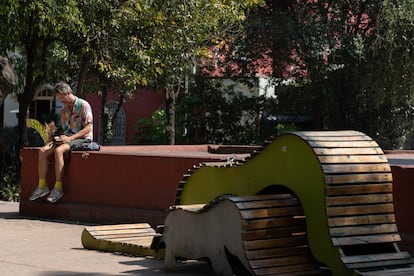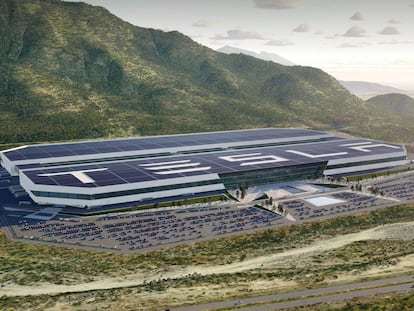The strength of the peso is deterring many Americans from moving to Mexico
The Mexican currency has strengthened 16% against the dollar in the last two years, impacting not just tourism, but also the number of U.S. citizens living in the country


Brighton West describes his move to Mexico as a “little bit of an accident.” The 51-year-old American was living in Oregon and spending the winter months in California to get away from the rain. He and his wife had searched the market for a house there but were priced out. “It was incredibly expensive,” he recalls. In 2019, to celebrate his wife’s birthday, they booked a weekend trip to a place called La Paz, in the state of Baja California, Mexico.
“Neither of us had been there before, but I read a blog post about it and thought it looked cool”, he says. “During those three days we saw this house on the beach and talked to a real estate agent. We were amazed at how inexpensive it was, especially considering we were living in San Diego at the time where a house like that would be millions of dollars. This one cost $160,000!”
With the rise of remote work, Americans moved to Mexico at a record pace between 2019 and 2022. The Wests were part of that trend and closed a deal on their Mexico home in February 2020, just weeks before the first Covid-19 lockdowns began. Lately though, they’ve seen their purchasing power diminish as the Mexican currency has sustained a relatively long period of appreciation against the dollar. Resident permits are down and so is tourism, which experts argue is also to do with the strong currency.
“People are definitely delaying plans to move because they’re hoping that if they wait a year or two, the peso is going to go back up and they’ll be able to afford more”, he says. West opened a YouTube channel called “Almost Retiring in Mexico” where he provides practical information for those looking to make the same move. His videos rack up tens of thousands of views, so he set up a consultancy on the side. In a recent video, he answers a viewer’s question: how high would the peso have to go for life in Mexico to be as expensive as in the United States? According to his calculations, at about 8 pesos per dollar. The currency currently trades just below the 17-peso mark “and some re predicting that it’s going to continue on this trend”, he says.
The number of Americans who received a residence permit in Mexico increased 70% between 2019 and 2022, a record jump. Last year, the number dropped by 7%, according to the government’s most recent data. Also, GDP from tourism contracted 0.2% compared to the previous quarter, according to the National Institute of Statistics (Inegi), which shows how the currency’s strength is strongly impacting the economy, says Carlos Capistrán, chief economist for Mexico and Canada at Bank of America (BofA).
“Even when you adjust for inflation in both Mexico and the U.S. and consider what we economists call the ‘real’ exchange rate, we are talking about a strong appreciation of the peso”, Capistrán says. His estimates show that the price of goods and services in Mexico, relative to those in the U.S., have gone up 30% in the last three years.
In a way, Capistrán says, what we are seeing is a more intense stage of economic integration between Mexico and the U.S. “Now that the United States is in a trade fight with China, it is expected that it will integrate more with Mexico and since the pandemic, this integration is accelerating so we see many more people from the U.S. and from Canada living in Mexico”, he adds.
Another part of this equation has to do with how expensive life has gotten for Americans in their own country. Jeremy Horpedahl, a professor of Economics at the University of Central Arkansas (UCA), says that the price of housing has skyrocketed in the last couple of decades, forcing many to move to more affordable cities. “We’re starting to run out of cities in the U.S., that’s the problem,” Horpedahl says. “As I’ve looked into it, the number of cities that are now considered affordable in terms of housing is shrinking, which could be part of what you’re seeing with people moving to Mexico.”
“The middle class today has more wealth and income than they’ve ever had before, but a lot of that wealth is tied up in housing. The value of their houses has gone up, and that’s in some sense good for them, but if they want to move somewhere new, they’re going to face higher housing costs wherever they go”, he adds.
Tom Fullerton, a professor of Economics and Finance at the University of Texas at El Paso, expects the strengthening of the peso to reduce the number of retirees relocating to Mexico. “It will also reduce the attractiveness of border residents with Mexico passports from purchasing real estate on the south side of the international boundary in cities such as Tijuana, Mexicali, Nogales, Ciudad Juárez, Nuevo Laredo, Reynosa, and Matamoros”, he says.
“Of course, the price of housing, health care, and medicine in the United States will continue to entice residents from north of the border to relocate to, and shop in, Mexico”, he adds. The cost of healthcare, which has ballooned in the U.S. over the last decade or so, is another factor that foreigners find attractive. In Mexico, the universal health public care system, while insufficient and flawed, effectively pushes down the costs of private care.
Both Fullerton and Capistrán see the peso sustaining its strength in the near term. “It is worth noting that the peso is no longer undervalued against the dollar and that means that, barring any major financial, economic, or political crises, the currency premium is not likely to return anytime soon”, Fullerton says.
Capistrán and his team at BofA expect the currency to trade below its current levels and hit 18.25 pesos per dollar by the end of the year, driven mostly by changes in monetary policy. “We expect a modest depreciation in the following months at the end of the year, but this is still a very strong peso. The real exchange rate is going to remain very strong”, he adds.
Meanwhile, West remains optimistic about his life in Mexico and his online business. “A lot of people are delaying their plans,” he says, “but there is also a huge chunk of people that are saying, ‘I moved to Mexico because life’s too short and if the peso changes, life is still too short. So, I’m going to enjoy my life no matter what’.”
Sign up for our weekly newsletter to get more English-language news coverage from EL PAÍS USA Edition









































